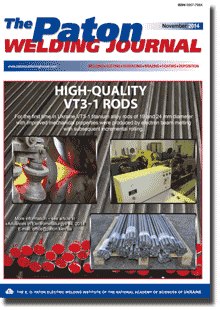| 2014 №11 (03) |
DOI of Article 10.15407/tpwj2014.11.04 |
2014 №11 (05) |

The Paton Welding Journal, 2014, #11, 24-27 pages
INTEGRATED EVALUATION OF EFFECT OF MAIN IMPURITIES ON WELDABILITY OF COPPER
V.A. ANOSHIN1, V.M. ILYUSHENKO1, A.N. BONDARENKO1, E.P. LUKIANCHENKO1 and A.K. NIKOLAEV2
1E.O. Paton Electric Welding Institute, NASU. 11 Bozhenko Str., 03680, Kiev, Ukraine. E-mail: office@paton.kiev.ua
2OJSC «Institute Tsvetmetobrabotka». 5 Pyzhevsky Lane, 119017, Moscow, RF. E-mail: post@cmet.ru
Abstract
The wide application of commercial grades of copper, containing different impurities, in many fields of industry requires profound analysis of their influence on weldability. At the present work the integrated evaluation of effect of main impurities on copper susceptibility to formation of cracks and pores was made using electron-fractographic and X-ray analysis and also new methods, developed by the authors, for evaluation of tendency of copper to formation of solidification cracks. It is shown that simultaneous presence of different impurities in copper unlike the binary system of copper-impurity reduces its tendency to solidification crack formation. Content of 0.2 % Ni increases the crack resistance of copper. It was established that level of influence of low-melting impurities on crack formation in weld metal and near-weld zone depends on their distribution coefficient. It was for the first time established that low-melting surface-active impurities with a low distribution coefficient (K< 0.05) increase the tendency of welds to pore formation. The obtained results of investigations allow developing new consumables for welding of copper and its alloys. 15 Ref.. 2 Tables, 3 Figures.
Keywords: copper, impurities, solidification cracks, pores, electron-fractographic and X-ray spectral analysis, distribution coefficient
Received: 19.06.14
Published: 28.11.14
References
1. Nikolaev, A.K., Kostin, S.A. (2012) Copper and heat-resistant alloys: Fundament. Refer. Book. Moscow: DPK Press.
2. Korenyuk, Yu.M. (1967) Resistance to crack formation in welds containing Bi and Pb impurities in welding of copper. Svarochn. Proizvodstvo, 4, 8-10.
3. Abramovich, V.R., Demyantsevich, V.P., Efimov, L.A. (1988) Fusion welding of copper and alloys on copper base. Leningrad: Mashinostroenie.
4. Kobayashi, T., Kuwana, T., Ando, M. et al. (1970) Gas metal-arc welding of copper. Transact. of JWS, 1, 61-71.
5. Littleton, J., Lammas, J., Jordan, M.E. (1974) Nitrogen porosity in shielded gas arc welding of copper. Welding J., 53(2), 561-566.
6. Ilyushenko, V.M. (1985) Weldability of commercial grades of copper. In: Advanced methods of welding and surfacing of heavy non-ferrous metals and alloys. Kiev: PWI.
7. (2013) Welding and surfacing of copper and alloys on its base. Kiev: IAW.
8. Yatsimirsky, V.K., Vyazmitinova, O.M. (1972) Surface activity of components in alloys and their catalytic properties. In: Wettability and surface properties of melts and solids, 134-136. Kiev: Naukova Dumka.
9. Grigoriev, A.G., Alshevsky, V.S., Zhukovitsky, A.A. et al. (1972) Effect of metal vapors on surface tension of solid copper. Ibid., 171-174.
10. Nizhenko, V.I., Floka, L.I. (1981) Surface tension of metals and alloys: Refer. Book. Moscow: Metallurgiya.
11. Semenchenko, V.K. (1957) Surface phenomena in metals and alloys. Moscow: GITEL.
12. Anoshin, V.A., Gurevich, S.M., Ilyushenko, V.M. et al. (1981) Effect of surface-active elements on deformation capacity of nickel and monel. Avtomatich. Svarka, 7, 46-48.
13. Anoshin, V.A., Ilyushenko, V.M., Bondarenko, A.N. et al. Method for evaluation of metal susceptibility to cracking. USSR author's cert. 747662. Int. Cl. B 23 K 28/00. Publ. 15.07.80.
14. Patskevich, I.R., Deev, G.F. (1974) Surface phenomena in welding processes. Moscow: Metallurgiya.
15. Ilyushenko, V.M., Anoshin, V.A., Bondarenko, A.N. et al. (1981) Weldability of copper deoxidized by phosphorus. Avtomatich. Svarka, 12, 59-60.
